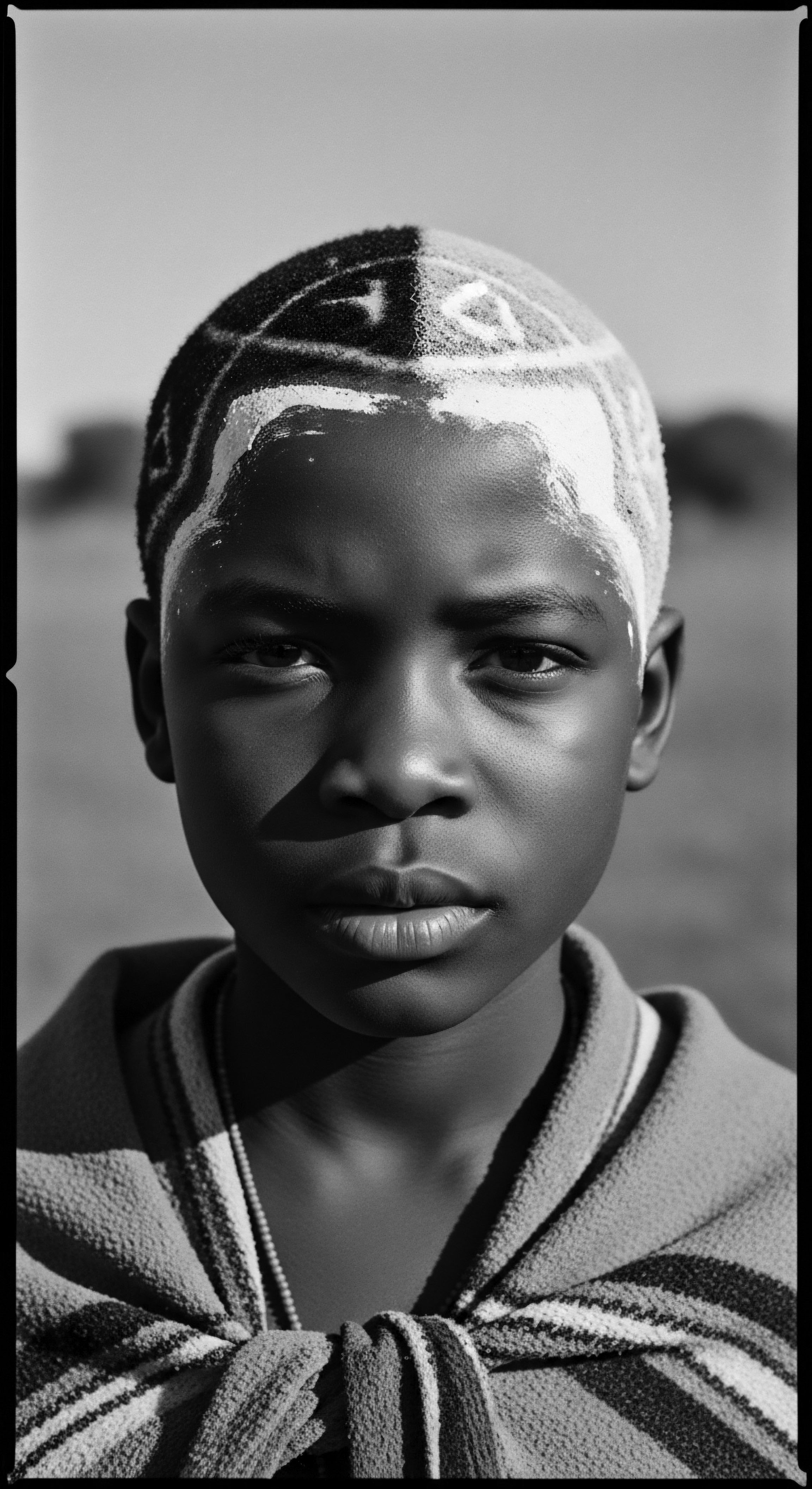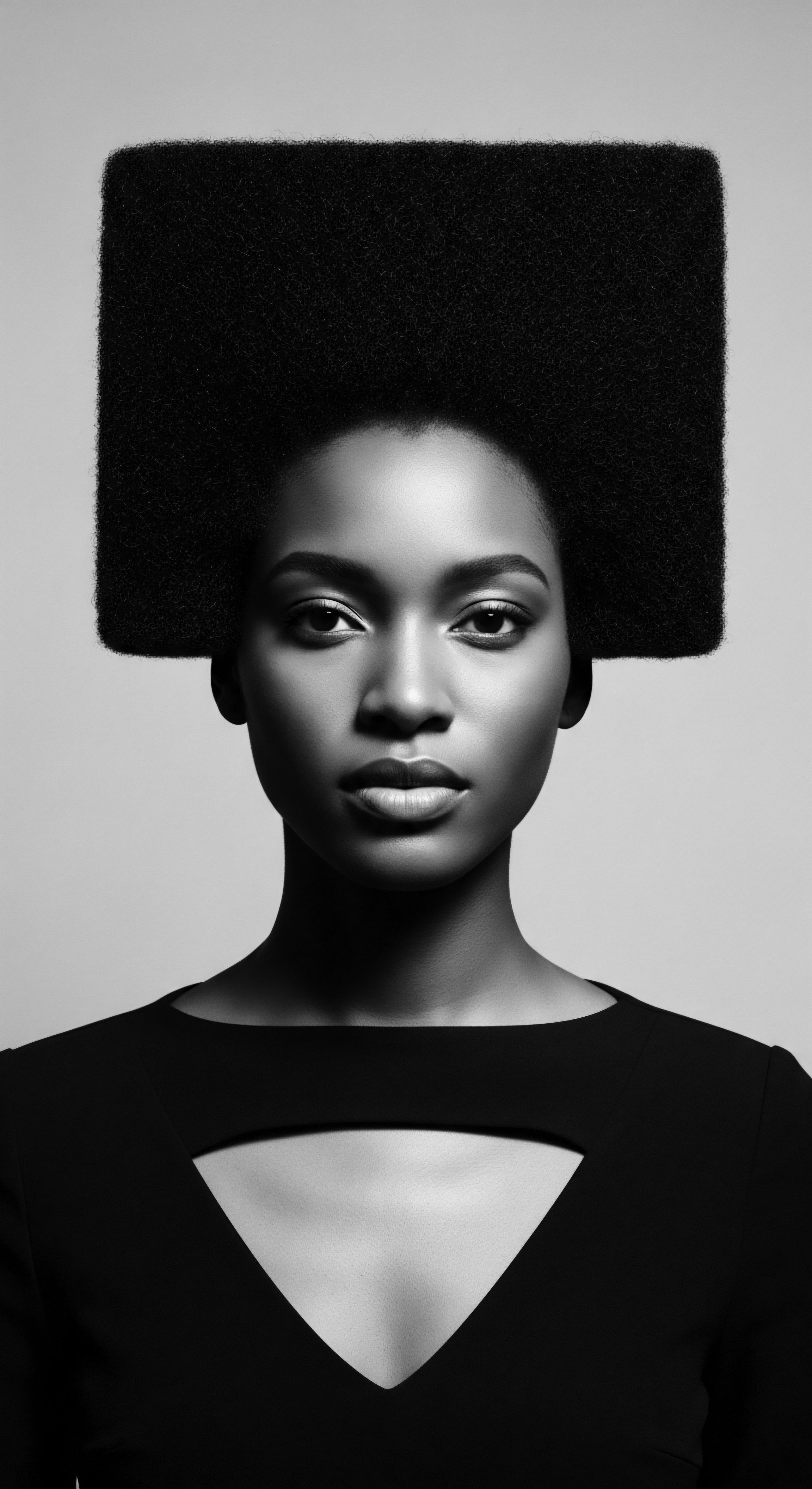
Fundamentals
The concept of Identity Through Combs might, at first reflection, seem straightforward, perhaps a simple designation for a grooming tool. Yet, its true meaning stretches far beyond such a superficial understanding. This is a profound articulation of how an elemental implement, the comb, has served as a silent, yet exceptionally potent, keeper of heritage, a shaper of self, and a transmitter of cultural truth, particularly within the annals of textured hair traditions.
From its earliest rudimentary forms, the comb was more than an object for detangling or styling. It was a primary interface between an individual and their hair, which itself holds vast cultural significance. The comb’s simple action, tracing through strands, connects us to ancient practices of care and adornment. Its fundamental purpose, to order and define hair, translated directly into social and personal ordering, making it a critical, almost intimate, instrument.
Identity Through Combs elucidates how this seemingly simple tool serves as a profound cultural artifact, shaping individual and communal understanding of self within textured hair traditions.
When considering textured hair—coily, kinky, curly, and wavy patterns—the comb’s role gains an exceptional depth. These hair types, celebrated for their unique structural integrity and versatile nature, require distinct approaches to care. Ancient communities, attuned to the wisdom embedded in their surroundings, developed combs specifically suited to these unique hair formations.
These tools were not mass-produced; rather, they arose from an innate understanding of hair’s biological structure and its spiritual significance. Each tooth, each curve, was a thoughtful extension of the hand, designed to honor the hair’s natural inclinations, promoting health and allowing for expressive artistry.
The initial meaning of Identity Through Combs begins with this foundational premise ❉ that the act of combing, and the comb itself, became deeply entwined with daily rituals of self-attention and communal recognition. It was often the first tool children encountered in their hair journey, teaching them about their hair’s characteristics and the importance of its meticulous care. This early interaction established a lifelong connection to hair as a part of their bodily experience, reflecting broader societal values concerning cleanliness, presentation, and ancestral connection. The very shape and material of early combs often reflected available natural resources, creating a direct lineage from the earth to the head.

Early Cultural Significance
In many ancestral societies, the ownership and use of specific combs conveyed status or marked rites of passage. These objects became extensions of one’s identity, speaking volumes about the wearer’s age, marital status, or position within the community. The careful preparation of hair with these tools was often a communal act, particularly for women, fostering bonds and transmitting intergenerational knowledge about hair care, herbal remedies, and traditional styles. These communal moments cemented the comb’s role not just as a personal item, but as a silent participant in shared cultural experiences.
- Oral Traditions ❉ Storytelling often accompanied hair grooming, with combs as silent witnesses, linking the younger generation to the narratives of their ancestors.
- Material Choices ❉ Early combs, carved from bone, wood, or ivory, were selected not only for durability but for perceived spiritual properties or connection to specific animal totems, adding layers of meaning.
- Daily Rituals ❉ The regular practice of combing served as a meditative ritual, a moment of connection with one’s body and, by extension, one’s lineage.

Intermediate
Moving beyond the foundational insights, the intermediate meaning of Identity Through Combs delves into the complex interplay between evolving cultural dynamics, the politics of appearance, and the enduring resilience of textured hair heritage. Here, the comb transforms from a mere implement into a potent symbol, a silent testament to survival, resistance, and self-affirmation across centuries of diasporic experiences. The significance of the comb deepens as we acknowledge its critical role in challenging imposed beauty norms and preserving ancestral wisdom in the face of systemic pressures.
The forced displacement and enslavement of African peoples presented immense challenges to existing hair care practices. Yet, even in the crucible of unimaginable adversity, the comb retained its essential function as a tool of cultural continuity. Makeshift combs, crafted from readily available materials, were instrumental in maintaining hair health and identity, even when conditions were designed to strip individuals of their humanity.
These rudimentary tools became symbols of quiet defiance, serving as a physical manifestation of an unbroken link to traditions and self-worth. The continued practice of hair grooming, often with these simple combs, was an act of resilience, a declaration of dignity in oppressive circumstances.

Combs as Cultural Artifacts and Markers of Belonging
The comb, in various forms, has acted as a profound cultural artifact, a tangible link to heritage. In numerous African societies, hair combs were exquisitely carved, serving as more than mere tools. They were works of art, often imbued with symbolic motifs that conveyed lineage, status, fertility, or spiritual protection.
These detailed designs were not arbitrary; they spoke a language understood by the community, translating abstract beliefs into concrete forms. The patterns etched onto a comb might represent a clan’s totem, a historical event, or a philosophical concept, making the act of styling hair a re-affirmation of one’s place within a rich cultural narrative.
Consider the profound significance of combs within specific ethnic groups. The Akan People of Ghana, for example, have a deeply symbolic relationship with their combs. The Dua Koro comb, meaning “one tree,” is a particularly striking instance. Carved from a single piece of wood, its single-tooth design embodies the profound Akan philosophical concept of unity (Ephraim-Mensah, 2017).
This comb is not simply a styling tool; it is a visual proverb, a reminder of communal strength and the importance of collective identity rooted in shared ancestry. For generations, the Dua Koro has been utilized not only in daily hair care but also in ceremonial contexts, connecting individuals to the broader narrative of their lineage and community. This singular comb, modest in its form, therefore possesses an extraordinary purport, signifying an entire worldview.
The comb’s evolution mirrors the journey of textured hair communities, from tools of necessity to powerful emblems of cultural reclamation and self-love.
The meaning of Identity Through Combs expanded dramatically during periods of cultural renaissance and political activism. In the mid-20th century, particularly within the Black Liberation movements, the Afro Pick emerged not just as a practical tool for maintaining voluminous Afro hairstyles, but as a radical statement of political and aesthetic defiance. Its widespread adoption was a deliberate rejection of Eurocentric beauty standards that had long denigrated textured hair.
The Afro pick, with its distinct wide-set teeth and often adorned with a raised fist symbol, became a universally recognized icon of Black pride and self-acceptance. This era solidified the comb’s role as a tool of empowerment, allowing individuals to actively sculpt an identity that was authentically theirs, rooted in a reclamation of ancestral aesthetics.
| Historical Context of Comb Use Ancient African combs often feature symbolic carvings, denoting status, spiritual beliefs, or tribal affiliation. |
| Contemporary Relevance to Identity Modern artisans and brands create combs that incorporate traditional motifs, fostering a connection to ancestral aesthetics and cultural pride. |
| Historical Context of Comb Use Makeshift combs during enslavement were vital for maintaining hygiene and a sense of self, a quiet act of defiance. |
| Contemporary Relevance to Identity The conscious selection of wide-toothed combs and picks by textured hair individuals today mirrors a legacy of self-care and rejection of oppressive beauty standards. |
| Historical Context of Comb Use The ceremonial use of combs in rites of passage marked significant life transitions and instilled communal values. |
| Contemporary Relevance to Identity Combs gifted for significant milestones (e.g. first hair cut, graduation) often carry sentimental meaning, symbolizing growth and the continuity of personal and cultural journeys. |
| Historical Context of Comb Use The enduring presence of the comb, adapting across eras, underscores its foundational and evolving importance in shaping identity within textured hair communities. |
The enduring legacy of the comb, therefore, speaks to its exceptional capacity to adapt and evolve, mirroring the journey of textured hair itself. Its role is a testament to the fact that identity is not merely an internal construct; it is often outwardly expressed through tangible cultural objects and the rituals that surround them. The comb, a seemingly unassuming item, has always been at the heart of this expression, acting as a bridge between the individual, their hair, and their collective heritage.

Academic
The academic elucidation of Identity Through Combs demands a rigorous examination, transcending anecdotal observation to anchor itself within the robust frameworks of material culture studies, critical race theory, and the anthropology of embodiment. This term signifies the profound socio-cultural, psychological, and historical construction of identity, inextricably linked to the design, use, and symbolic representation of hair combs, particularly within Black and mixed-race communities. It posits that the comb is not a passive instrument but an active agent in the dialectic between self and society, a conduit through which individuals negotiate historical trauma, express agency, and cultivate belonging. The meaning, therefore, is rooted in its instrumental role in the performance of self and the preservation of ethnocultural narratives.
From an academic perspective, the concept addresses the complex interplay of several theoretical constructs. Firstly, it touches upon Actor-Network Theory, wherein the comb, as a non-human actor, participates in shaping social relations and identities. Its physical properties—materiality, tooth spacing, handle design—directly influence hair care practices, which in turn affect the aesthetics and health of textured hair. These aesthetic outcomes are not neutral; they carry dense semiotic loads, signaling adherence to or defiance of prevailing beauty standards.
Secondly, the term engages with the sociology of the body, recognizing hair as a primary site of identity negotiation. The comb facilitates the manipulation of this bodily appendage, rendering visible the invisible threads of cultural meaning and personal investment.

The Comb as a Tool of Reclamation and Resistance
Historical scholarship reveals the comb as a consistently deployed artifact in the assertion of identity against hegemonic forces. During colonial periods and the transatlantic slave trade, the deliberate suppression of indigenous hair practices was a tool of cultural annihilation. Yet, the ingenuity of enslaved Africans in fashioning combs from thorns, sticks, or discarded materials speaks volumes about the unwavering commitment to maintaining cultural vestiges and personal dignity (Hooks, 1992).
This continuity of practice, often clandestine, served as a powerful, non-verbal declaration of selfhood in environments designed to dismantle it. The very existence of these rudimentary combs, passed down or recreated, represented an unbroken lineage of self-care and an unyielding connection to ancestral ways of being.
The formal academic definition of Identity Through Combs therefore includes ❉ The scholarly interpretation delineates it as a dynamic construct wherein the selection, modification, and ritualistic application of the hair comb functions as a salient indicator and active determinant of individual and collective identity, particularly among populations with textured hair, serving as both a tangible link to ancestral practices and a symbolic instrument of resistance against dominant aesthetic paradigms. This deep analysis illuminates how the object’s presence shapes sociological understandings of beauty, agency, and cultural continuity.
A rigorous analytical lens on the Afro Pick, for instance, illuminates its profound sociopolitical valence beyond mere utility. Its widespread adoption during the Black Power movement of the 1960s and 70s was a deliberate act of cultural and political reassertion. This period witnessed a conscious departure from hair straightening practices, a legacy of assimilationist pressures, toward natural hairstyles that celebrated the inherent volume and texture of Black hair. The Afro pick, with its extended tines, was indispensable for cultivating and maintaining these styles.
Academically, the Afro pick became a semiotic marker of Black liberation, signifying a rejection of Eurocentric aesthetic imperialism and an embrace of an African-centered worldview. The symbolism embedded in its often-adorned handle—the clenched fist—further cemented its political purport, transforming a grooming tool into a powerful emblem of solidarity and self-determination. The significance of this object is not merely its utility, but its embeddedness within a larger struggle for human rights and cultural validation.
Scholarly inquiry reveals Identity Through Combs as a complex theoretical construct, demonstrating how the comb actively shapes socio-cultural and psychological identity through its material form and symbolic function within textured hair communities.
The academic significance of combs also extends to their role in Memory and Material Culture. Combs found in archaeological sites or preserved within ethnographic collections offer invaluable insights into historical hair practices, social stratification, and artistic expressions of past societies. Their analysis provides tangible evidence for understanding how individuals interacted with their hair and, by extension, how they constructed and communicated their identities across various temporal and geographical contexts.
For example, forensic anthropology sometimes uses comb residue analysis to ascertain hair type and care products used in ancient populations, further connecting the tool directly to the personal and cultural practices of its owner. Such interdisciplinary approaches broaden our understanding of the comb’s enduring and multifaceted contributions to identity formation.

Interconnected Incidences Across Disciplines
The profound meaning of Identity Through Combs is best understood by analyzing its interconnected incidences across various academic fields ❉
- Archaeology and Anthropology ❉ Examinations of ancient combs yield data on material availability, craftsmanship, and the evolution of grooming practices. This provides direct insights into the daily lives, social structures, and aesthetic values of historical populations, revealing how combs functioned as cultural markers long before recorded history.
- Sociology and Critical Race Studies ❉ These fields dissect the comb’s role in constructing and deconstructing racialized beauty standards. The historical imposition of smooth hair as a norm, contrasting sharply with the natural state of textured hair, positions the comb as an instrument of either conformity or resistance, embodying complex power dynamics.
- Psychology and Self-Identity Theory ❉ The personal ritual of combing can foster self-affirmation, particularly for individuals reclaiming their natural hair. This act strengthens self-esteem and body positivity, linking external appearance to internal psychological well-being. The therapeutic aspects of mindful hair care, facilitated by appropriate combs, contribute to a holistic sense of self.
- Art History and Semiotics ❉ The artistic embellishment of combs, seen in many traditional African cultures, transforms them into symbolic objects carrying deep semiotic meanings. These designs communicate cultural narratives, spiritual beliefs, and social hierarchies, making the comb a visual language component of identity expression.
The longevity of the comb as an object of material culture, coupled with its profound symbolic load, ensures its continued relevance in understanding human identity. The scholarship continues to deepen, examining nuances such as gendered uses of combs, regional variations in design and meaning, and the contemporary digital dissemination of hair comb aesthetics. Each thread of inquiry reinforces the understanding that the comb is far more than a simple tool; it is a complex artifact, a repository of history, and a constant companion in the journey of self-discovery and cultural expression for those with textured hair.

Reflection on the Heritage of Identity Through Combs
The journey through the definition of Identity Through Combs reveals an exquisite narrative, one that flows from the elemental biology of hair strands to the expansive horizons of human culture and self-expression. This concept, far from being a static academic construct, is a living, breathing archive of ancestral wisdom, a testament to the enduring human spirit, and an affirmation of beauty in its myriad forms. Its echoes resound from the earliest carved implements, whispering stories of communal bonds forged over shared hair rituals, to the resonant hum of modern brushes affirming a reclaimed sense of self.
Within the unique universe of textured hair, the comb has been a steadfast companion through epochs of change, challenge, and celebration. It has witnessed the tender care passed from elder to youth, the quiet acts of resistance in times of oppression, and the vibrant declarations of pride in eras of awakening. Its presence underscores the profound connection between the tangible act of grooming and the intangible essence of identity. Every stroke, every detangling motion, becomes a re-engagement with a lineage of care, a reaffirmation of a heritage that celebrates the inherent strength and versatility of coily, kinky, and curly hair.
The comb, in its quiet power, consistently reminds us that our hair is not merely a physiological attribute; it is a vibrant extension of who we are, where we come from, and where we are going. It invites us to honor the knowledge passed down through generations, to understand that ancient practices often hold truths that modern science later affirms. The enduring significance of Identity Through Combs lies in its gentle invitation to look deeper, to see not just a tool, but a keeper of stories, a symbol of resilience, and a guide along the path of holistic well-being rooted deeply in ancestral wisdom. This profound recognition allows us to view our combs not just as instruments, but as cherished artifacts, each one holding a whisper of the past and a promise for the future.

References
- Appiah, K. A. (1997). In My Father’s House ❉ Africa in the Philosophy of Culture. Oxford University Press.
- Ephraim-Mensah, P. (2017). Akan Adinkra Symbols ❉ Visual Representation of Philosophical Ideas. University of Ghana.
- Hooks, B. (1992). Black Looks ❉ Race and Representation. South End Press.
- Thompson, R. F. (1993). Flash of the Spirit ❉ African and Afro-American Art and Philosophy. Vintage Books.
- Mercer, K. (1994). Welcome to the Jungle ❉ New Positions in Black Cultural Studies. Routledge.
- Gates Jr. H. L. (2011). Colored People ❉ A Memoir. Vintage Books.
- Byrd, A. L. & Tharps, L. D. (2014). Hair Story ❉ Untangling the Roots of Black Hair in America. St. Martin’s Press.
- Patton, S. F. (2020). African-American Art. Oxford University Press.
- Banks, I. (2000). Hair ❉ A Cultural History of Hair Fashion in America. W. W. Norton & Company.
- White, D. (2009). The Hairdresser of Harare ❉ A Novel. Little, Brown and Company.
